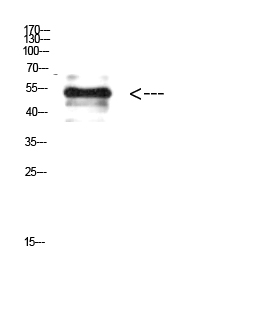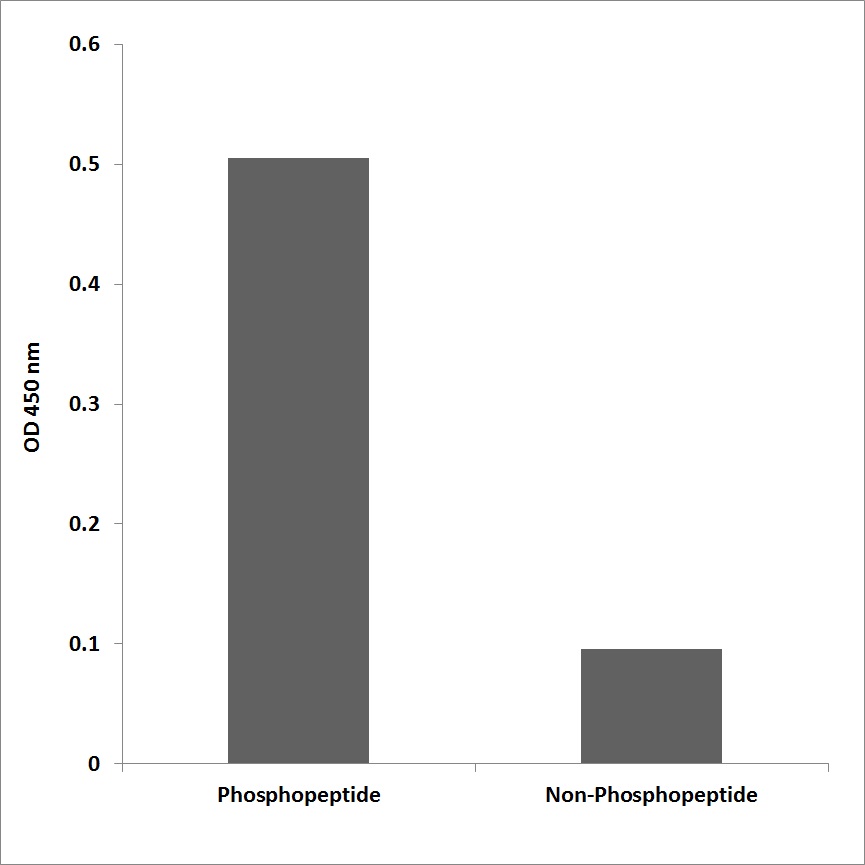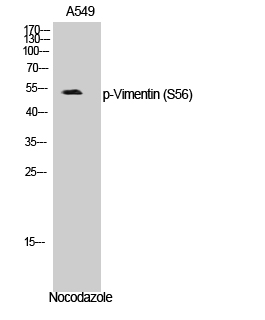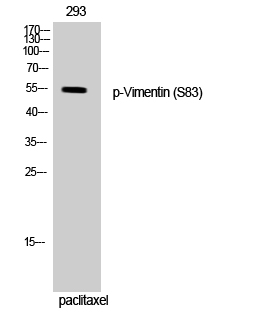Vimentin (Phospho Tyr38) Polyclonal Antibody
- Catalog No.:YP1209
- Applications:WB;ELISA
- Reactivity:Human:Y38;Mouse:Y38;Rat:Y38
- Target:
- Vimentin
- Fields:
- >>Epstein-Barr virus infection;>>MicroRNAs in cancer
- Gene Name:
- VIM
- Protein Name:
- vimentin
- Human Gene Id:
- 7431
- Human Swiss Prot No:
- P08670
- Mouse Swiss Prot No:
- P20152
- Rat Swiss Prot No:
- P31000
- Immunogen:
- Synthesized phospho-peptide around the phosphorylation site of human Vimentin (Phospho-Tyr38)
- Specificity:
- This antibody detects endogenous levels of Vimentin at Human:Y38;Mouse:Y38;Rat:Y38, It doesn't reacte with total protein.
- Formulation:
- PBS, pH 7.4, containing 0.02% sodium azide as Preservative and 50% Glycerol.
- Source:
- Polyclonal, Rabbit,IgG
- Dilution:
- WB 1:500-10000 ELISA: 1:10000
- Purification:
- The antibody was affinity-purified from rabbit serum by affinity-chromatography using specific immunogen.
- Concentration:
- 1 mg/ml
- Storage Stability:
- -15°C to -25°C/1 year(Do not lower than -25°C)
- Other Name:
- VIM
- Observed Band(KD):
- 51kD
- Background:
- This gene encodes a member of the intermediate filament family. Intermediate filamentents, along with microtubules and actin microfilaments, make up the cytoskeleton. The protein encoded by this gene is responsible for maintaining cell shape, integrity of the cytoplasm, and stabilizing cytoskeletal interactions. It is also involved in the immune response, and controls the transport of low-density lipoprotein (LDL)-derived cholesterol from a lysosome to the site of esterification. It functions as an organizer of a number of critical proteins involved in attachment, migration, and cell signaling. Mutations in this gene causes a dominant, pulverulent cataract.[provided by RefSeq, Jun 2009],
- Function:
- function:Vimentins are class-III intermediate filaments found in various non-epithelial cells, especially mesenchymal cells.,online information:Vimentin entry,PTM:One of the most prominent phosphoproteins in various cells of mesenchymal origin. Phosphorylation is enhanced during cell division, at which time vimentin filaments are significantly reorganized.,sequence caution:Intron retention.,similarity:Belongs to the intermediate filament family.,subunit:Homopolymer. Interacts with HCV core protein. Interacts with LGSN and SYNM.,tissue specificity:Highly expressed in fibroblasts, some expression in T- and B-lymphocytes, and little or no expression in Burkitt's lymphoma cell lines. Expressed in many hormone-independent mammary carcinoma cell lines.,
- Subcellular Location:
- Cytoplasm . Cytoplasm, cytoskeleton . Nucleus matrix . Cell membrane .
- Expression:
- Highly expressed in fibroblasts, some expression in T- and B-lymphocytes, and little or no expression in Burkitt's lymphoma cell lines. Expressed in many hormone-independent mammary carcinoma cell lines.
- June 19-2018
- WESTERN IMMUNOBLOTTING PROTOCOL
- June 19-2018
- IMMUNOHISTOCHEMISTRY-PARAFFIN PROTOCOL
- June 19-2018
- IMMUNOFLUORESCENCE PROTOCOL
- September 08-2020
- FLOW-CYTOMEYRT-PROTOCOL
- May 20-2022
- Cell-Based ELISA│解您多样本WB检测之困扰
- July 13-2018
- CELL-BASED-ELISA-PROTOCOL-FOR-ACETYL-PROTEIN
- July 13-2018
- CELL-BASED-ELISA-PROTOCOL-FOR-PHOSPHO-PROTEIN
- July 13-2018
- Antibody-FAQs
- Products Images

- Western Blot analysis of HELA cells using Antibody diluted at 500. Secondary antibody(catalog#:RS0002) was diluted at 1:20000

- Enzyme-Linked Immunosorbent Assay (Phospho-ELISA) for Immunogen Phosphopeptide (Phospho-left) and Non-Phosphopeptide (Phospho-right), using Vimentin (Phospho-Ser38) Antibody

- Western blot analysis of lysates from 293 cells treated with paclitaxel, using p-Vimentin (Phospho-Ser38) antibody.



